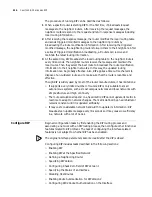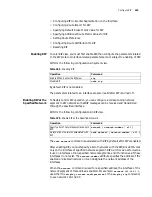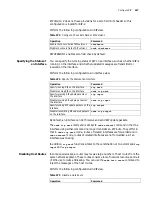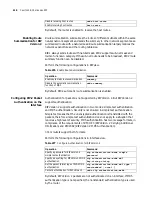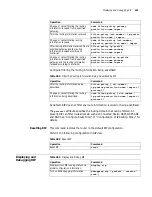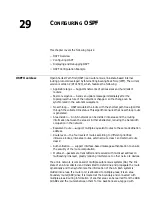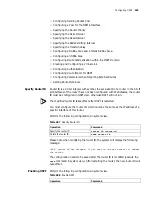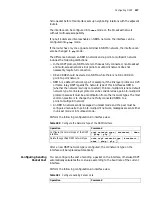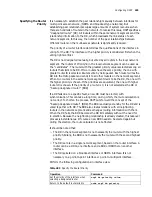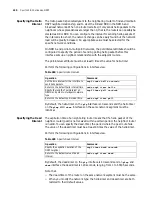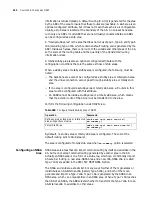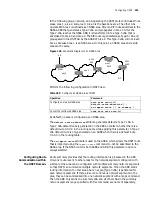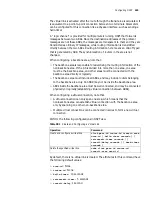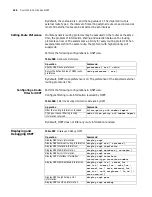
426
C
HAPTER
29: C
ONFIGURING
OSPF
By default, OSPF is disabled.
Associating an Area-id
with the Specified
Interface
The OSPF protocol divides the autonomous system into areas. An area is the
logical group of the router. Some routers belong to different areas (called area
boundary router ABR), while a network segment can only be in one area. In other
words, each interface running the OSPF protocol must be put in a specific area.
The area is flagged with an area ID. The ABR transmits routing information
between areas.
In addition, in the same area, all routers must agree unanimously to the parameter
configurations of this area. So, in the configuration of routers in the same area,
most configuration data must be considered on the basis of this area. Incorrect
configurations make it impossible for adjacent routers to transfer information to
each other, or can even lead to the blocking or self-loop of routing information.
Perform the following configurations in interface view.
Table 489
Associate an Area-id with the Specified Interface which runs OSPF
No area-id is associated with the specified interface by default after OSPF is
enabled.
After OSPF is enabled, you must specify an area-id associated with the specified
interface. OSPF only works on the specified interface.
Configuring the
Network Type of the
OSPF Interface
The OSPF protocol calculates the route on the basis of the topological structure of
the neighboring network of this router. Each router describes the topology of its
neighboring network and transmits this information to all other routers.
OSPF divides the network into 4 types according to the link layer protocols:
■
When the link layer is Ethernet, OSPF regards the network type as broadcast by
default.
■
When the link layer protocol is frame relay, HDLC and X.25, OSPF regards the
network type as NBMA by default.
■
No link layer protocol is considered as point-to-multipoint type by default. It is
usually manually modified from NBMA if the NBMA network is not wholly
interconnected.
■
When the link layer protocol is PPP, LAPB, OSPF regards the network type as
point-to-point by default.
NBMA is a Non Broadcast Multi Access network. The typical network is X.25 and
frame relay. Configure the poll-interval to specify the period for sending a polling
Enable OSPF and enter into the OSPF view
ospf enable
Turn off OSPF
undo ospf enable
Operation
Command
Specify an area-id associated with the
specified interface which runs OSPF
ospf enable area
area-id
Delete an area-id associated with the
specified interface
undo ospf enable area
area-id
Summary of Contents for Router 3032
Page 1: ...http www 3com com 3Com Router Configuration Guide Published March 2004 Part No 10014299...
Page 4: ...VPN 615 RELIABILITY 665 QOS 681 DIAL UP 721...
Page 6: ...2 ABOUT THIS GUIDE...
Page 7: ...I GETTING STARTED Chapter 1 3Com Router Introduction Chapter 2 3Com Router User Interface...
Page 8: ...4...
Page 16: ...12 CHAPTER 1 3COM ROUTER INTRODUCTION...
Page 34: ...30...
Page 60: ...56 CHAPTER 3 SYSTEM MANAGEMENT...
Page 98: ...94 CHAPTER 6 DISPLAY AND DEBUGGING TOOLS...
Page 110: ...106...
Page 114: ...110 CHAPTER 8 INTERFACE CONFIGURATION OVERVIEW...
Page 158: ...154 CHAPTER 10 CONFIGURING WAN INTERFACE...
Page 168: ...164...
Page 188: ...184 CHAPTER 13 CONFIGURING PPPOE CLIENT...
Page 192: ...188 CHAPTER 14 CONFIGURING SLIP Router ip route static 0 0 0 0 0 0 0 0 10 110 0 1...
Page 248: ...244 CHAPTER 16 CONFIGURING LAPB AND X 25...
Page 320: ...316...
Page 330: ...326 CHAPTER 20 CONFIGURING IP ADDRESS...
Page 362: ...358 CHAPTER 21 CONFIGURING IP APPLICATION...
Page 374: ...370 CHAPTER 23 CONFIGURING IP COUNT...
Page 406: ...402 CHAPTER 25 CONFIGURING DLSW...
Page 408: ...404...
Page 452: ...448 CHAPTER 29 CONFIGURING OSPF...
Page 482: ...478 CHAPTER 30 CONFIGURING BGP...
Page 494: ...490 CHAPTER 31 CONFIGURING IP ROUTING POLICY...
Page 502: ...498...
Page 508: ...504 CHAPTER 33 IP MULTICAST...
Page 514: ...510 CHAPTER 34 CONFIGURING IGMP...
Page 526: ...522 CHAPTER 36 CONFIGURING PIM SM...
Page 528: ...524...
Page 532: ...528 CHAPTER 37 CONFIGURING TERMINAL ACCESS SECURITY...
Page 550: ...546 CHAPTER 38 CONFIGURING AAA AND RADIUS PROTOCOL...
Page 590: ...586 CHAPTER 40 CONFIGURING IPSEC...
Page 599: ...IX VPN Chapter 42 Configuring VPN Chapter 43 Configuring L2TP Chapter 44 Configuring GRE...
Page 600: ...596...
Page 638: ...634 CHAPTER 43 CONFIGURING L2TP...
Page 649: ...X RELIABILITY Chapter 45 Configuring a Standby Center Chapter 46 Configuring VRRP...
Page 650: ...646...
Page 666: ...662...
Page 670: ...666 CHAPTER 47 QOS OVERVIEW...
Page 700: ...696 CHAPTER 49 CONGESTION MANAGEMENT...
Page 706: ...702 CHAPTER 50 CONGESTION AVOIDANCE...
Page 707: ...XII DIAL UP Chapter 51 Configuring DCC Chapter 52 Configuring Modem...
Page 708: ...704...
Page 762: ...758 CHAPTER 52 CONFIGURING MODEM...



